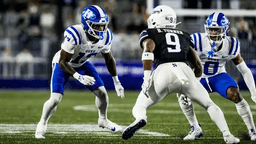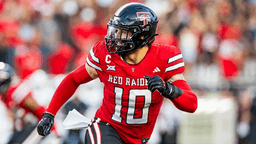Does the NFL have a Quarterback Development problem?
NFL teams getting mixed results with first round quarterbacks
By: Cole Muzio · Draft Carolina · 1y

Photo: Forbes
As Jayden Daniels leads the Washington Commanders to an unexpected 6-2 record, his stellar season is reminiscent of the rookie campaign C.J. Stroud put together in 2023, when he quickly emerged as one of the league’s top signal callers. Unfortunately, some of the other young QBs aren’t fairing so well.
Bryce Young is being teased as “gettable” for a 4th rounder after the 2023 #1 overall selection was benched earlier this season. Anthony Richardson has now been benched in favor of Joe “how on earth is he even still around” Flacco and Will Levis is really struggling.
This phenomenon led Sam Block of ESPN to make the following post on X: https://x.com/theblockspot.
Countless pontificators are now echoing the “QB development problem” angle. However, those cherry-picked stats don’t really echo reality. Of the NFL’s starting QBs, 8 are 25 or younger, 14 are between 26- 30, 5 between 31-35, and 5 are older than 35. That’s a normal curve and aligns with what one might expect.
Over half (17) of the league’s starters are with the team that drafted them – including most of the best QBs (largely representative of the best teams in the league). Even more (21) were first round draft picks, indicating that conventional wisdom of drafting a QB high remains the way to go.
From a statistical perspective, 6 of the top 10 passers in the NFL were taken in the first round. Only 5 of the top 10 rushers meet that description, 5 of the top 10 receivers, 1 of the top 10 tacklers, and 2 of the top 10 in interceptions. Of the top 10 in sacks, that matches the passing numbers with 6.
None of this indicates any sort of trend toward a development problem, and a basic understanding of Draft history would show that a 50% first round/QB development rate is about what can be expected.
Moreover, on a case-by-case basis, most of these development issues are predictable. Of the occurrences cited by Block, Richardson was considered a very mediocre college QB who simply happened to be an elite athlete. While his career still could pan out, it was known that he would take a lot of seasoning, and he’s the type of QB that typically would sit on the bench for a year or two upon coming into the league.
Will Levis was taken in the 2nd round and wasn’t seen as a surefire starter. Trey Lance came from North Dakota State and then had injury issues. Zach Wilson came from BYU and had a whole bunch of red flags, and anyone halfway decent at QB evaluations could have told you that Mac Jones and Kenny Pickett were not future NFL starters.
Bryce Young and Justin Fields are a little bit different. Both had prolific college careers from premier programs, and both were drafted highly (Young at #1 overall). I’ll be candid and say that I was not a fan of Young’s game. I did not see an NFL starter – especially when asked to be the savior of a terrible Panthers franchise.
Fields, however, I did see as a future NFL star, and I’m not entirely sure I was wrong. He was drafted by a QB-killing franchise, stuck with an atrocious Offensive Coordinator (have you seen what Luke Getsy has done to the Raiders?), and jettisoned earlier-than-planned because Caleb Williams fell into their lap.
None of these instances are indicative of an NFL struggling to develop QBs.
Below is a loose ranking of NFL starters and the pecking order I’d give them from the perspective of “if I were a coach for an NFL team for the rest of the season, who would I want as a starter.” There’s plenty of nitpicking that can be done with these rankings, but the purpose here is to highlight an NFL that has a very strong future ahead at the premier position in sports.
Note: QBs in bold were drafted in the first round and * notates those who have not left the team that drafted them. Teams where injuries, benching, and lousy play make their situation muddy will have a / to denote both “starters,” but only the first one listed was counted in compiling the stats above.
1. Pat Mahomes, Kansas City Chiefs (29)*
2. Lamar Jackson, Baltimore Ravens (27)*
3. Josh Allen, Buffalo Bills (28)*
4. Joe Burrow, Cincinnati Bengals (27)*
5. C.J. Stroud, Houston Texans (23)*
6. Jordan Love, Green Bay Packers (25)*
7. Brock Purdy, San Francisco 49ers (24)*
8. Jared Goff, Detroit Lions (30)
9. Jayden Daniels, Washington Commanders (23)*
10. Jalen Hurts, Philadelphia Eagles (26)*
11. Kirk Cousins, Atlanta Falcons (36)
12. Trevor Lawrence, Jacksonville Jaguars (25)*
13. Tua Tagovailoa, Miami Dolphins (26)*
14. Dak Prescott, Dallas Cowboys (31)*
15. Geno Smith, Seattle Seahawks (34)
16. Baker Mayfield, Tampa Bay Bucs (29)
17. Justin Herbert, Los Angeles Chargers (26)*
18. Sam Darnold, Minnesota Vikings (27)
19. Kyler Murray, Arizona Cardinals (27)*
20. Aaron Rodgers, New York Jets (40)
21. Bo Nix, Denver Denver Broncos (24)*
22. Caleb Williams, Chicago Bears (22)*
23. Matthew Stafford, Los Angeles Rams (36)
24. Russell Wilson (35)/ Justin Fields (25), Pittsburgh Steelers
25. Derek Carr, New Orleans Saints (33)
26. Daniel Jones, New York Giants (27)*
27. Joe Flacco (39)/ Anthony Richardson (22)* Indianapolis Colts
28. Andy Dalton (37), Bryce Young (23)*, Carolina Panthers
29. Deshaun Watson (29)/ Jameis Winston (30), Cleveland Browns
30. Jacoby Brissett (31)/ Drake Maye* (22), New England Patriots
31. Will Levis (25)/ Mason Rudolph (29), Tennessee Titans
32. Gardner Minshew (28), Aidan O’Connell (26)*, Las Vegas Raiders





Comments:
Log in or sign up to read and post comments.